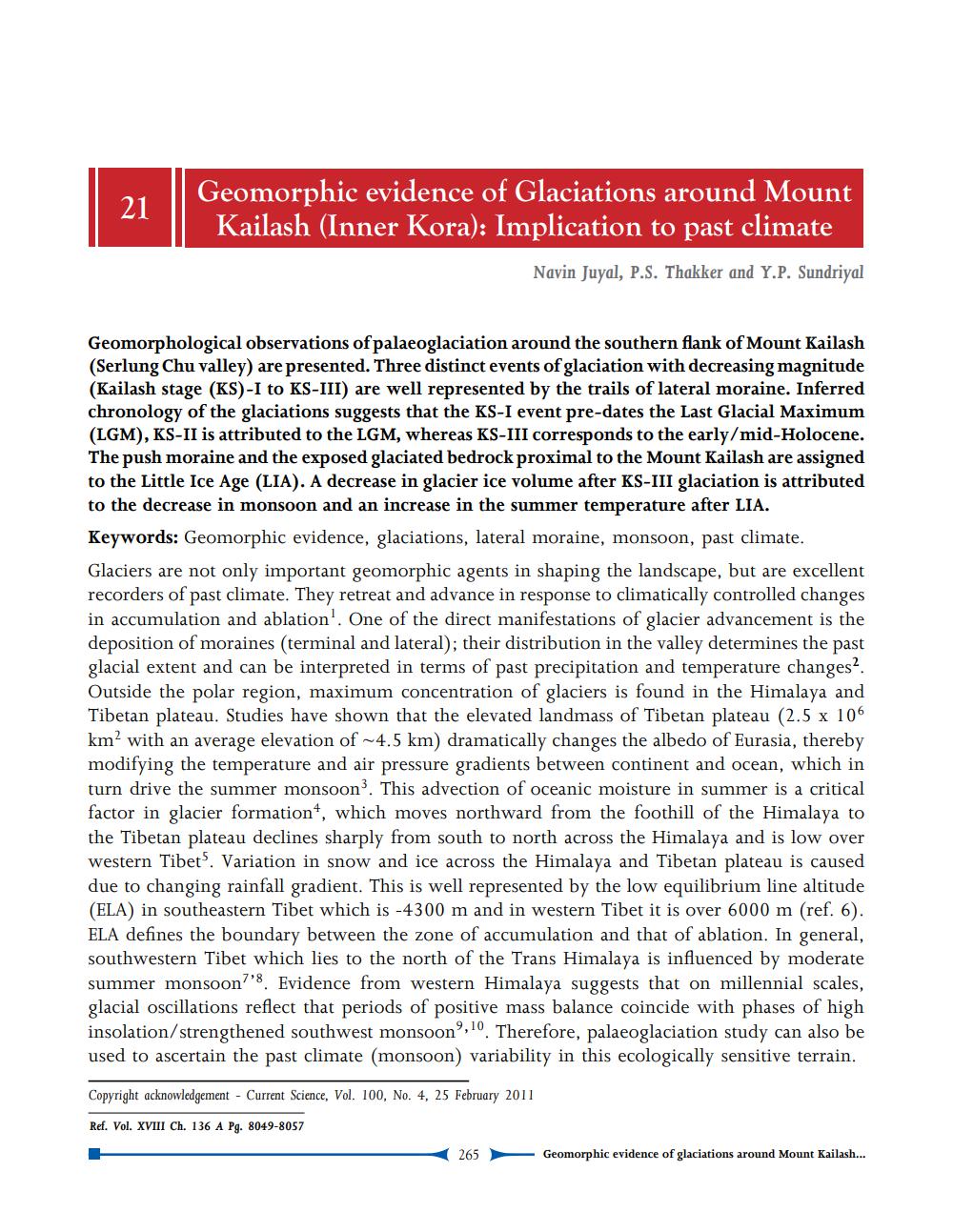________________
Geomorphic evidence of Glaciations around Mount Kailash (Inner Kora): Implication to past climate
Navin Juyal, P.S. Thakker and Y.P. Sundriyal
Geomorphological observations of palaeoglaciation around the southern flank of Mount Kailash (Serlung Chu valley) are presented. Three distinct events of glaciation with decreasing magnitude (Kailash stage (KS) -I to KS-III) are well represented by the trails of lateral moraine. Inferred chronology of the glaciations suggests that the KS-I event pre-dates the Last Glacial Maximum (LGM), KS-II is attributed to the LGM, whereas KS-III corresponds to the early/mid-Holocene. The push moraine and the exposed glaciated bedrock proximal to the Mount Kailash are assigned to the Little Ice Age (LIA). A decrease in glacier ice volume after KS-III glaciation is attributed to the decrease in monsoon and an increase in the summer temperature after LIA.
Keywords: Geomorphic evidence, glaciations, lateral moraine, monsoon, past climate. Glaciers are not only important geomorphic agents in shaping the landscape, but are excellent recorders of past climate. They retreat and advance in response to climatically controlled changes in accumulation and ablation'. One of the direct manifestations of glacier advancement is the deposition of moraines (terminal and lateral); their distribution in the valley determines the past glacial extent and can be interpreted in terms of past precipitation and temperature changes?. Outside the polar region, maximum concentration of glaciers is found in the Himalaya and Tibetan plateau. Studies have shown that the elevated landmass of Tibetan plateau (2.5 x 106 km2 with an average elevation of ~4.5 km) dramatically changes the albedo of Eurasia, thereby modifying the temperature and air pressure gradients between continent and ocean, which in turn drive the summer monsoon?. This advection of oceanic moisture in summer is a critical factor in glacier formation“, which moves northward from the foothill of the Himalaya to the Tibetan plateau declines sharply from south to north across the Himalaya and is low over western Tibet. Variation in snow and ice across the Himalaya and Tibetan plateau is caused due to changing rainfall gradient. This is well represented by the low equilibrium line altitude (ELA) in southeastern Tibet which is -4300 m and in western Tibet it is over 6000 m (ref. 6). ELA defines the boundary between the zone of accumulation and that of ablation. In general, southwestern Tibet which lies to the north of the Trans Himalaya is influenced by moderate summer monsoon?'8. Evidence from western Himalaya suggests that on millennial scales, glacial oscillations reflect that periods of positive mass balance coincide with phases of high insolation/strengthened southwest monsoon",10. Therefore, palaeoglaciation study can also be used to ascertain the past climate (monsoon) variability in this ecologically sensitive terrain.
Copyright acknowledgement - Current Science, Vol. 100, No. 4, 25 February 2011
Ref. Vol. XVIII Ch. 136 A Pg. 8049-8057
265
Geomorphic evidence of glaciations around Mount Kailash...




